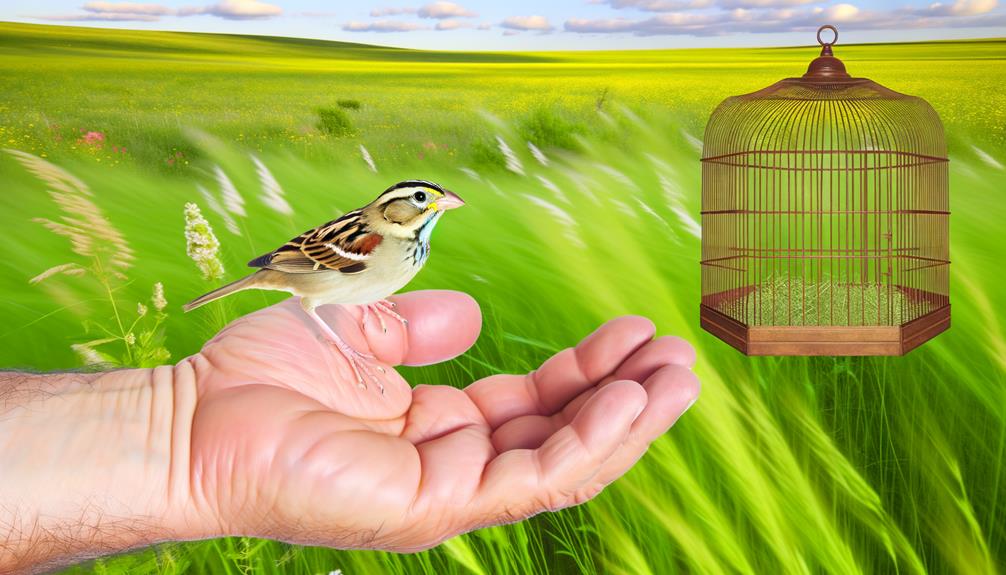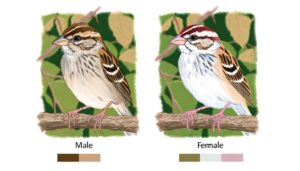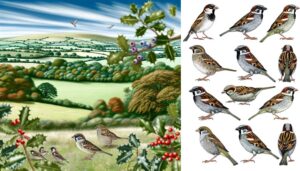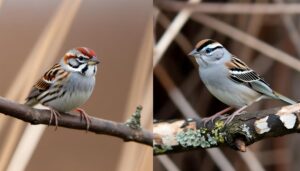10 Steps to Relocate a Grasshopper Sparrow Safely
Relocating a Grasshopper Sparrow requires careful planning. Proper handling is essential, using gentle movements and soft cloths to minimize stress.
One must secure a habitat mimicking the bird's natural grassland environment, with plenty of tall grass, sparse shrubbery and abundant insects. Safety is paramount.
Evaluate predator threats, weather conditions, and monitor the sparrow's health diligently. After relocation, regular health checks and habitat adjustments are part of maintaining the bird's wellbeing.
The intricacies of carrying out post-relocation care smoothly are awaiting further investigation.

Key Takeaways
- Research the Grasshopper Sparrow's preferred habitat, diet, and nesting habits to secure a suitable relocation area.
- Handle the bird with gentle movements, using a soft cloth for security, warmth, and minimal stress.
- Choose a relocation site with plenty of tall grass, sparse shrubbery, an abundance of insects, and minimal human disturbance.
- Ensure the sparrow's safety by evaluating potential predator threats, ensuring suitable weather conditions, and monitoring the bird's health.
- Provide post-relocation care by creating an environment mirroring the sparrow's natural habitat, maintaining proper feeding practices, and monitoring the bird's adaptation.
Understanding the Grasshopper Sparrow
Although small in size, the Grasshopper Sparrow is a fascinating bird species, characterized by its distinctive buzzing song that eerily mimics the sound of a grasshopper.
This sparrow's scientific name, Ammodramus savannarum, reflects its preference for grassland habitats. It's not easily spotted due to its shy nature and tendency to stay low in tall grasses.
It's a ground nesting bird, laying 3-6 eggs in a well-hidden nest. The Grasshopper Sparrow has a unique diet consisting mainly of insects during the breeding season, but it switches to seeds and grains in winter.
Understanding these aspects of the Grasshopper Sparrow's life is essential before undertaking any efforts to relocate this species, as it guarantees the bird's survival and well-being in its new environment.
Preparing for Relocation
Before embarking on the task of moving a Grasshopper Sparrow, it's vital to carefully prepare for the process, taking into account the bird's specific habitat preferences, dietary needs, and nesting behaviors.
Start by researching the bird's preferred environment—grasslands with tall, dense vegetation. Then, secure a suitable relocation area that mimics this natural habitat. This guarantees the sparrow's survival and breeding success post-relocation.
It's also important to understand the bird's dietary requirements—mainly insects and seeds—and have these readily available. Consider the bird's nesting habits as well; these sparrows usually nest on ground level in grassy clumps. Creating a similar nesting area in the new location will help the bird feel familiar and secure.
This thorough preparation is a fundamental step in a successful relocation.
Proper Handling Techniques
One must handle a Grasshopper Sparrow with utmost care, making sure to use gentle, delicate movements that won't alarm or distress the bird. It's key to approach the sparrow slowly, avoiding sudden actions.
Once close enough, use a soft cloth to gently wrap the bird, providing a sense of security and warmth. The sparrow's head should be carefully covered to prevent panic and the wings must be held close to the body to avoid injury.
While holding, it's important to apply enough pressure to restrain, but not so much that it's uncomfortable for the bird. Always remember, handling should be minimal to reduce stress.
Handling a Grasshopper Sparrow requires precision, patience, and a deep understanding of the bird's needs and instincts.
Choosing the Right Habitat
After ensuring the sparrow's safety through mindful handling, it's equally important to contemplate the proper habitat where the bird will thrive best.
The Grasshopper Sparrow's preferred habitat is open grassland, and there are a few key features to look for when choosing a relocation site:
- Plenty of grass: They need an abundant supply of tall grass to nest and forage in.
- Sparse shrubbery: A few shrubs are ideal for perching, but too many can attract predators.
- Insect availability: Being insectivores, they require an area rich in grasshoppers and other insects.
- Lack of human disturbance: Choose a location where human interference is minimal to prevent stress and further displacement.
Ensuring Sparrow Safety
Upon finding the ideal relocation site, it's important to guarantee the sparrow's safety. This involves focusing on factors such as predator threats, suitable weather conditions, and the bird's overall health.
Predator threats involve evaluating the presence of predatory birds or mammals, and adjusting the habitat if needed.
Weather conditions play a crucial role in the sparrow's survival. Hence, it's vital to ensure the environment isn't prone to extreme weather that could endanger the bird.
Lastly, the sparrow's health must be closely monitored. Any signs of stress or illness prior to relocation could greatly impact its chances of survival.
Post-Relocation Care
Upon successful relocation, the Grasshopper Sparrow requires careful post-relocation care.
This encompasses proper feeding practices, closely monitoring the bird's health, and setting up a conducive environment that mimics its natural habitat.
Each of these steps is essential to guarantee the bird's survival and adaptation in its new home.
Proper Feeding Practices
How should you feed a Grasshopper Sparrow after its relocation? Proper feeding practices are essential for the bird's successful adaptation to its new environment.
- Diet: Grasshopper Sparrows primarily eat insects, especially grasshoppers, hence their name. Supplement their diet with seeds during the colder seasons.
- Feeding Schedule: Feed them twice a day, morning and evening.
- Portion Size: Overfeeding can lead to health issues. Provide small portions that can be eaten within 15 minutes.
- Hydration: Always make sure a clean source of water is available.
Monitoring Bird's Health
Once you've established a suitable feeding routine for the relocated Grasshopper Sparrow, keeping a watchful eye on the bird's health becomes your next priority. Regular monitoring of the bird's weight, plumage condition, and behavior can provide valuable insight into its overall health.
Here's a simplified health-check guide:
| Health Indicator | Significance |
|---|---|
| Weight | Sudden weight loss could indicate illness or stress. |
| Plumage Condition | Dull or ruffled feathers often signal poor health. |
| Behavior | Changes in eating, sleeping, or social behaviors can be early signs of distress. |
Setting Up Environment
Ensuring the Grasshopper Sparrow's new environment mirrors its natural habitat as closely as possible is essential for its post-relocation care. This process involves several critical steps:
- Habitat Simulation: Mimic the sparrow's original environment, including vegetation, soil, and water conditions.
- Food Source: Establish a consistent food supply, ensuring the sparrow's dietary needs are met.
- Safety Measures: Provide safe areas for nesting and hiding, protecting the sparrow from potential predators.
- Monitoring: Regularly observe the sparrow's behavior, health, and adaptation to the new setting.
Each step requires meticulous attention to detail, precision, and scientific understanding. Properly setting up the environment not only helps the sparrow settle in but also promotes its long-term survival and well-being.
Conclusion
To sum up, relocating a grasshopper sparrow, like the successful 2017 case in Ohio, involves careful preparation, gentle handling, and suitable habitat selection. Ensuring their safety and providing post-relocation care are pivotal for the bird's survival.
With a detailed, scientific approach, we can help these beautiful creatures thrive in their new environment, contributing positively to our ecosystem. Remember, every small step in conservation makes a significant impact.






